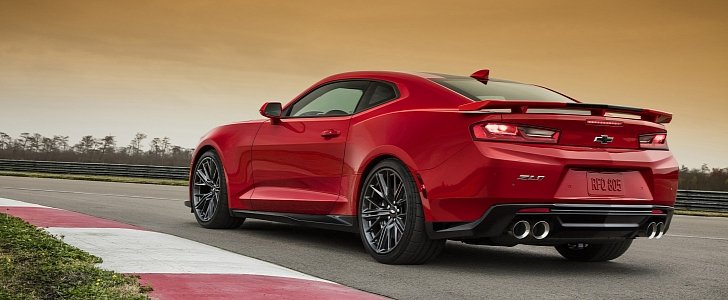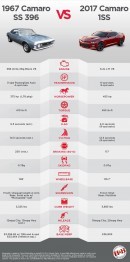H&H Classic Parts has made a comparison between the 1967 Chevrolet Camaro and the 2017 Camaro. It shows how performance has improved over 50 years, but also how expensive has the Camaro become.
The comparison graphic you can view in the photo gallery of this story puts the 1967 Camaro SS 396 to its modern equivalent, the 2017 Camaro 1SS.
The new model is 360 pounds (163 kg) heavier than the one made 50 years ago, and the price of this model has increased by 50% according to H&H chart, which has taken inflation into account. The newer model is also longer, but not by a dramatic margin.
The old Camaro with the SS 396 with the L78 engine package had a price of $3,256 in 1967, which comes to about $23,464 in today’s dollars with inflation adjustment.
Meanwhile, the 2016 Camaro 1SS has an MSRP price of $36,905. With the use of a reverse inflation calculator, its equivalent rate in 1967 would be $5,117, according to our calculations, which are not calculated with the most advanced scientific methods (we used an online reverse inflation tool). This does not apply to all versions of the Camaro, mind you.
In spite of the price increase, the 2017 Camaro brings customers more performance, safety, technology, and increased handling capabilities. A comparison on the skid pad shows the old model was capable of 0.78g, while the 2017 Camaro 1SS can go as high as 0.97g.
The acceleration on the quarter mile has improved by just 2.2 seconds, but the time of the old Camaro is an estimate. Meanwhile, 0-60 times have dropped by 2.5 seconds, also with an estimation for the old model.
Engine power and torque were also boosted significantly, as was fuel economy, which is not entirely comparable because of different EPA standards of the time.
The biggest improvement in our book is 60-0 braking distance, which is estimated at 250 feet (76.2 meters) for the old car, while the new model needs just 117’ (35.6 meters) to stop in ideal conditions.
Modern tires, more gears, and engine technology have helped, evidently, and so has the suspension system, which is correctly described by H&H as “light years away.”
While the old Camaro has its charm, it is fair to appreciate the advancement of technology over the five decades that have flown since the launch of this model.
The new model is 360 pounds (163 kg) heavier than the one made 50 years ago, and the price of this model has increased by 50% according to H&H chart, which has taken inflation into account. The newer model is also longer, but not by a dramatic margin.
The old Camaro with the SS 396 with the L78 engine package had a price of $3,256 in 1967, which comes to about $23,464 in today’s dollars with inflation adjustment.
Meanwhile, the 2016 Camaro 1SS has an MSRP price of $36,905. With the use of a reverse inflation calculator, its equivalent rate in 1967 would be $5,117, according to our calculations, which are not calculated with the most advanced scientific methods (we used an online reverse inflation tool). This does not apply to all versions of the Camaro, mind you.
In spite of the price increase, the 2017 Camaro brings customers more performance, safety, technology, and increased handling capabilities. A comparison on the skid pad shows the old model was capable of 0.78g, while the 2017 Camaro 1SS can go as high as 0.97g.
The acceleration on the quarter mile has improved by just 2.2 seconds, but the time of the old Camaro is an estimate. Meanwhile, 0-60 times have dropped by 2.5 seconds, also with an estimation for the old model.
Engine power and torque were also boosted significantly, as was fuel economy, which is not entirely comparable because of different EPA standards of the time.
The biggest improvement in our book is 60-0 braking distance, which is estimated at 250 feet (76.2 meters) for the old car, while the new model needs just 117’ (35.6 meters) to stop in ideal conditions.
Modern tires, more gears, and engine technology have helped, evidently, and so has the suspension system, which is correctly described by H&H as “light years away.”
While the old Camaro has its charm, it is fair to appreciate the advancement of technology over the five decades that have flown since the launch of this model.





























